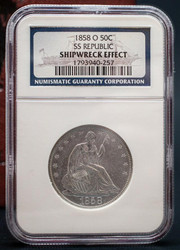SS Republic's Incredible Numismatic Treasures
Posted by Bullion Shark on May 20th 2022
SS Republic's Incredible Numismatic Treasures
Coin collectors have long been fascinated by famous shipwrecks of vessels that were carrying lots of valuable coins such as the SS Central America, or the ship of gold, which had almost half a million ounces of gold coins when it went down in 1857 due to a hurricane. Or the SS Garisoppa, known as the British Treasury ship, that had seven million ounces of silver went it was hit by a German torpedo in 1941.
And often such ships and their amazing numismatic and other treasures are only discovered more than 100 years after they went down. For example, the Garisoppa rested on the bed of the Atlantic Ocean until 2011 when the UK government awarded the firm Odyssey marine Exploration Inc. a contract to salvage it, which led to the recovery of 1.4 million ounces of silver. And although such operations are expensive and take a long time, they can be very lucrative. In this case, the company got to keep 80% of the silver with the rest going to the UK government!
Some of these shipwrecks with valuable cargo, especially when found in international waters have led to prolonged international legal battles with foreign countries as to the true owners of the valuables that are retrieved.
Another very famous shipwreck is the SS Republic, which while on its way from New York to New Orleans in 1865 encountered strong gales when it was off the coast of Georgia that soon became a raging hurricane. The ship is one that had existed under other names previously and was used extensively for long voyages such as across the Atlantic.
On October 24 the ship lost power and was adrift at sea. Then the boiler failed, and water began to pour into the hold. By the next day, the ship went down. Most of the crew and passengers had managed to get away on four small boats and a makeshift raft, while others jumped into the water and started swimming. Those on the ships were rescued a couple days later by passing ships, while those who swam did not survive in several cases.
The vessel’s cargo contained thousands of gold and silver coins with a face value of about $400,000. In July 2003, Odyssey Marine Exploration, Inc. located the wreck off the coast of Georgia in 1,700 feet of water, where gold coins and other artifacts like medicine bottles were all over the sea floor. The coins they recovered over the next 12 years hav an estimated value of $180 million!
In October and November 2003, a recovery vehicle called the ROV ZEUS brought over 750 gold eagles and double eagles and over 900 Liberty Seated Half dollars to the surface. By January 2004, over 17,000 coins with a face value of about $54,500 had been recovered. There were no other gold or silver denominations such as silver dollars as at that time (the Trade or Liberty Seated dollars) were used in maritime trade with China. The coins were conserved by NGC’s Numismatic Conservation Service.
The coins on such ships were typically stored either in canvas bags or sealed wooden kegs – with most of those on this ship in the latter that was easier to move as they could be rolled. The coins mostly had a thin, grimy film on them that was removed by NCS. Apparently, it helped protect the gold coins, which also fared much better than the half dollars because gold is the most inert of metals used for coinage.
A lot of the silver halves, on the other hand, developed porosity from the salt water, while a limited number were still pristine. The rest were said to have “shipwreck effect”, which appears on the NGC grading labels for those coins.
By mid-2004, about 31,000 silver coins and 3,425 gold coins had been brought back to the surface, which was still only 18% of the original cargo of coins. By late 2004, they reached over 50,000 coins, mostly as more half dollars were found.
As for which specific coins were included, almost all were Liberty Seated halves but there were some Capped Bust halves too. Interestingly, there were many die varieties and some rare coins struck at the New Orleans Mint when it had been taken by Confederate forces such as 1861-O coins, plus a small number of rare 1855-S halves.
As for the gold $10 coins, they mostly were found with the same distribution as the coins were minted, i.e., lots and lots of the common 1865 coins, but just one rare 1841-O. Other rare dates like 1852-O, 1857-O and one of the finest 1858 coins were found in very small numbers.
The pattern tended to hold for the $20 gold coins with every date and mint mark from the start in 1850 through 1865 (except 1856-O), including a rare 1854-O in AU condition. There was also one very rare 1861-S with the “Paquet Reverse” – a special reverse die made by engraver Anthony C. Paquet plus 97 examples of this date with the regular reverse.
If one includes the silver coins, the SS Republic resulted in the discovery of more coins from this era (the end of the Civil War) than any other American vessel shipwreck. The coins were carefully marketed and sold for many years by dividing them into categories of rarity, grade and demand.
SS Republic Liberty Seated half dollars are still a popular collectible and are worth a premium over the same date that was not part of this famous shipwreck, including more common and rarer issues -- all certified by NGC and for the 1858-O including a book about this amazing story.
sources:
Q. David Bowers, Lost and Found: Coin Hoards and Treasures (Whitman, 2015)


